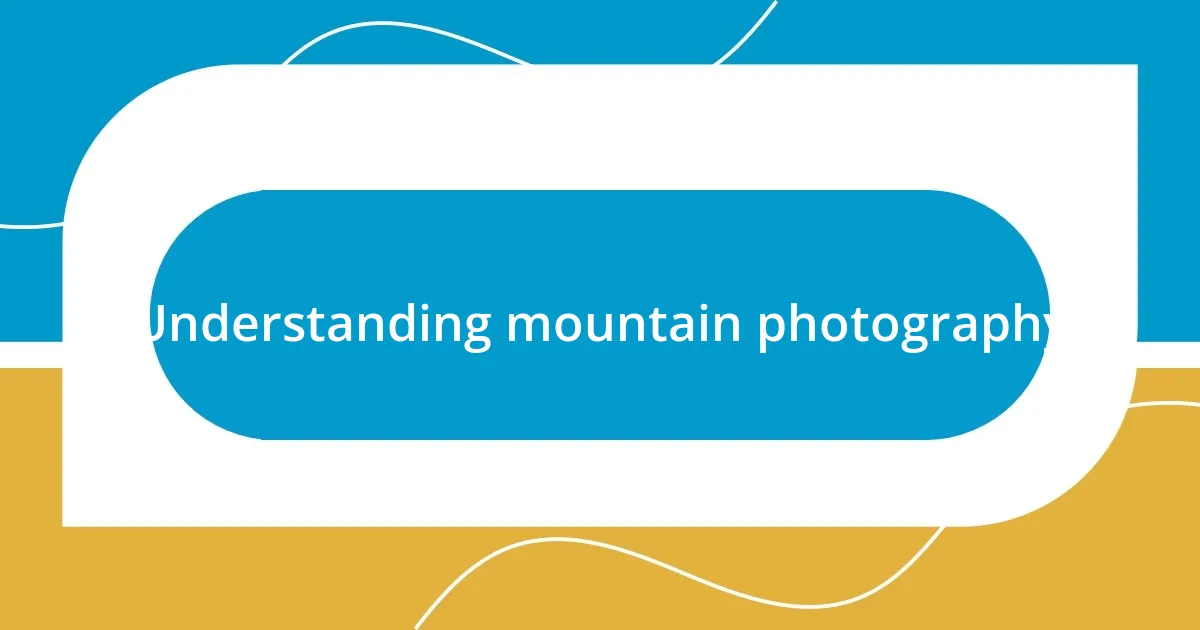Key takeaways:
- Understanding light and shadow is crucial for capturing the beauty of mountains, with optimal shooting times during sunrise and sunset enhancing the atmosphere.
- Choosing the right equipment, including a sturdy camera, wide-angle and telephoto lenses, and a tripod, can significantly improve mountain photography results.
- Composition techniques, like using the rule of thirds and incorporating foreground elements, enhance the depth and narrative of mountain images.
- Post-processing techniques such as adjusting contrast, saturation, and cropping can elevate mountain photographs from good to spectacular.

Understanding mountain photography
Mountain photography is a unique blend of artistry and challenge. I remember my first trip to the Rockies; I was captivated by the vastness and how the light shifted with each passing moment. It made me realize that understanding the interplay of light and shadow is crucial in capturing the awe-inspiring beauty of jagged peaks and rolling valleys.
As I delved deeper into the art, I found that the mood of a photograph can shift dramatically depending on the time of day. Have you ever stood on a mountaintop at sunrise? The soft pastels of dawn envelop the landscape, creating an ethereal atmosphere that is simply unforgettable. It taught me to appreciate not just the subject I was shooting, but the entire environment—how clouds roll in, how fog lingers, transforming the ordinary into the extraordinary.
Moreover, what I’ve learned over the years is that composition is key. Would you believe that sometimes, the best shots happen when you include a small element in the foreground—like a wildflower or a rock? It draws the viewer’s eye and gives perspective to those towering mountains. This attention to detail can create a connection between the viewer and the majestic landscape, making every image a personal experience.

Choosing the right equipment
Choosing the right equipment can make all the difference in capturing stunning mountain landscapes. When I first started out, I underestimated the importance of having the right gear, which led to some disappointing shots that didn’t quite reflect the beauty I was witnessing. After much trial and error, I learned that a sturdy camera, a good lens, and accessories like tripods are essential for mountain photography.
Here’s a quick list of must-have gear for any aspiring mountain photographer:
- Camera: A DSLR or mirrorless camera with manual controls.
- Lenses: A wide-angle lens (for sweeping vistas) and a telephoto lens (for distant mountains).
- Tripod: A sturdy tripod to stabilize your shots, especially during low-light conditions.
- Filters: Polarizing filters to reduce glare and enhance colors in the sky and water.
- Weather Protection: A weather-resistant bag or rain cover to protect your gear from the elements.
I vividly recall a rainy mountain hike where I was grateful for my weather-sealed camera. Not only did it withstand the downpour, but it also allowed me to capture the most moody, atmospheric photos that turned out to be some of my favorites. It’s these kinds of moments that really emphasize the importance of having reliable equipment when you’re out in the wild.

Best camera settings for mountains
Capturing the majesty of mountains involves more than just pointing and shooting; camera settings play a pivotal role. For instance, I often use an aperture between f/8 and f/16 to ensure sharp details across the entire image. It’s that depth of field that keeps both foreground elements and distant peaks in focus, creating a harmonious balance that draws viewers in. Trust me, when you see a well-defined mountaintop contrasting against a blurred foreground, it evokes an emotional reaction that a flat image simply can’t achieve.
Shutter speed is another aspect I meticulously adjust based on the scene and the desired outcome. When I shot a waterfall cascading down a rocky slope at the base of a mountain, I slowed down the shutter speed to around 1/4 second. This created a silky effect on the water, contrasting beautifully with the solidity of the rocks. I can assure you, this technique truly transforms a static shot into a dynamic storytelling piece that resonates with viewers.
Finally, consider ISO settings carefully. I typically keep my ISO as low as possible—around 100 to 200—when the light is good. But don’t hesitate to ramp it up when shooting in the early morning light or during dusk. Just last fall, I pushed my ISO to 1600 as I captured a breathtaking sunset, and the results were absolutely stunning despite the low light. It’s all about finding that sweet spot for each unique mountain scene.
| Setting | Recommendation |
|---|---|
| Aperture | f/8 to f/16 |
| Shutter Speed | 1/50 to 1/2000 sec |
| ISO | 100-200 (up to 1600 when necessary) |

Timing your shots for light
Timing your shots for light can significantly transform your mountain photography experience. I’ve found that the golden hour—just after sunrise and before sunset—offers the most magical light. The soft, warm tones can bring a serene beauty to rugged landscapes that harsh midday sun often struggles to capture. Can you imagine how a mountain bathed in that golden glow looks? It’s nothing short of breathtaking.
While planning your shoot, pay attention to weather patterns and the sun’s position. I remember one climb where I tracked the clouds all day, waiting patiently for them to part just as the sun dipped below the peaks. That brief moment illuminated the mountains with a stunning palette of colors that I had almost missed. Staying alert to these shifting conditions can lead to exceptional photos that tell a story of nature’s ever-changing beauty.
Don’t overlook the importance of shadows either. Strong shadows can add depth and texture, especially in the late afternoon. I vividly recall a shot where the shadows played over the craggy terrain, enhancing the dramatic feel of the landscape. It made me realize how crucial it is to be patient and wait for the right moment—you might just capture a scene that resonates deeply with you and your audience, creating a strong emotional connection.

Composing stunning mountain images
When it comes to composing stunning mountain images, the foreground can make a world of difference. I often include interesting elements like wildflowers or rocky outcrops in the foreground, which provide context and depth to the image. Can you picture a towering mountain behind a vibrant splash of color? It draws you in and creates a captivating narrative.
The rule of thirds is a powerful tool I embrace for composition. I position the horizon line in the upper or lower third, allowing the mountains to command attention. On one memorable hike, I positioned the peaks in the upper third, leading the viewer’s eye naturally up towards the expansive sky. This simple adjustment transformed a snapshot into a compelling composition that felt almost three-dimensional.
Another important aspect is the angle from which you shoot. Elevating your perspective can reveal patterns and textures that are often overlooked. Once, while standing on a rocky ledge, I captured a shot looking down at the valley below, where the mountains framed a winding river. That unique angle not only highlighted the grandeur of the landscape but also offered a fresh perspective that felt exhilarating. How often do we consider how our own vantage point can change the story a photograph tells?

Post-processing mountain photographs
Post-processing mountain photographs can elevate your images from good to spectacular. One technique I frequently use is adjusting the contrast and saturation to enhance the mountain’s textures and colors, making them pop. I distinctly remember a breathtaking shot of a snow-capped peak at sunset; after some careful tweaking in editing, it felt as though I had transported the scene right out of my mind and onto the screen.
Another vital aspect of post-processing is cropping. Often, I find that cropping out distractions can help focus attention on the mountains themselves. There was a time when I nearly deleted a photo because of an unnecessary foreground element, but a simple crop transformed it into a stunning representation of the majesty in front of me. Don’t you think that a little adjustment can sometimes breathe new life into an otherwise overlooked photograph?
Finally, I recommend playing with local adjustments, particularly in areas like shadows and highlights. I learned that selectively brightening certain regions can guide the viewer’s eye where I want it to go. On one occasion, I slightly brightened an area where a stream wound its way through the valley. This subtle change not only directed attention but also created a sense of depth, making the image more inviting. Have you experienced that moment when a small edit transforms your perception of a photograph? It’s truly magical.














